The Compleat Witch Pages | home
Sally Rand
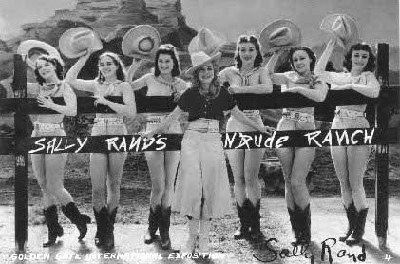
Sally Rand is an American icon, best known for her famous "fan dance." But, as with so many other celebrities, Miss Rand had a multifaceted career and personality that deserves (*ahem*) further exposure.
"Sally Rand" was born as Harriet Helen Gould Beck in the Ozark Mountain town of Elkton, Missouri on Easter Sunday, the 3rd of April, 1904. She was the daughter of Nettie Grove, a Pennsylvania Dutch Quaker, and Corporal William Beck, a veteran of the Spanish-American War. Teddy Roosevelt was President of the United States and there would come a time when little Helen would fall asleep in the great man's lap.
Sally was interested in dance from an early age and, literally, ran away with a carnival as a teenager. She later pursued such career opportunities as night club cigarette girl, artist's model, and cafe dancer.
Experience with the carnival led to employment with the Adoplh Bohm Chicago Ballet Company and the Ringling Brothers Circus. Thereafter, the path led to an association with the company of Gus Edwards, which also included Eddie Cantor, Walter Winchell, and George Jessel.
After leaving Gus Edwards, young Helen joined Will Seabury's Repertory Theatre Company. Sensing that a serious stage career was her destiny, she studied Chekov and Ibsen, among other playwrights. Believe it or not, our girl actually played Sadie Thompson in a production of "Rain" opposite, the then unknown, Humphrey Bogart.
The Seabury Company headed West in the early 1920's, and broke up shortly after its arrival in Los Angeles. Sally found herself unemployed, but in the film capital of the world.
Actually, "Sally" didn't find herself anywhere, because the aspiring performer was calling herself "Billy Beck" at that time. "Billy" made the rounds of the studios. Her carnival and circus background was such that she was able to land spots in comedy shorts produced by Mack Sennett and Hal Roach. One of her first stunts was to dive from a tall ladder into a small tank.
Finally, the trail led to feature roles. Cecil B. deMille was forming a stock company and found a place for Billie Beck. She credits deMille with giving her the new name--"Sally Rand." Thereafter, Miss Rand was cast in both leading and supporting roles in numerous silent films.
Sally was a WAMPAS baby star in 1927. When silent films gave way to "talkies," another career change became inevitable. Although Sally appeared in a few talking films, her prominent lisp foreclosed any chance of her being accepted as a major star of the silver screen.
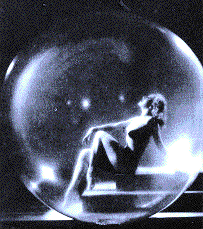
Sometime in her late 20's, the ever resourceful Sally, having dropped out of Columbia University, when the depression set in, got the idea that she could increase her fame (and not incidentally her bank account) by combining a talent for artistic dance with the always present demand on the part of hormone driven members of the male sex for a glimpse of feminine pulchritude. Or, to offer a more blunt assessment, lots of people enjoy seeing a pretty girl in the buff.
Of course Miss Rand was not the first to hit on the idea of stimulating the male libido. Susie Johnson had displayed her charms in 1895, securing a place in history as the central figure of the infamous "Pie Girl Dinner".
Initially coming to Chicago in a show called "Sweethearts on Parade," in 1932, Sally soon accepted a position at the Paramount Club, in response to an advertisement for "exotic acts and dancers." It was at the Paramount Club that she first performed the "fan dance," using two large ostrich feather fans purchased at a second-hand shop.
Following a "Lady Godiva" inspired stunt at the gates of the 1933 "Century of Progress" World's Fair, Sally became a featured performer in the "Streets of Paris" concession and catapulted into stardom on May 30, 1933, with her first performance of the now legendary "Fan Dance." A full account of the circumstances may be found in the book "Sally Rand - From Film to Fans," more fully described below.
Nearly every account of Sally Rand's career includes the declaration that she "danced nude at the 1933 World's Fair." Well, ... maybe. As often as not Sally Rand's "nudity" was actually a body stocking. Whatever the reality, the illusion was sensational. As Sally manipulated two pink seven-foot ostrich fans to conceal and reveal much, but not all, only the eagle-eyed could successfully claim to have seen anything.
As you might imagine, the act was an unqualified sensation. The diminutive (5' 1") damsel with the knockout figure (35-22-35) began packing them in by the thousands. And it wasn't long before the shouts hit the fans. Pillars of the community were outraged, public officials were consulted, and officers of the law were dispatched. Miss Rand found herself in court, answering to charges that certain performances at the Century of Progress Exposition were "lewd, lascivious, and degrading to public morals." To his credit, the judge was a man of sober perspective:
"There is no harm and certainly no injury to public morals when the human body is exposed, some people probably would want to put pants on a horse.
. . .
When I go to the fair, I go to see the exhibits and perhaps to enjoy a little beer. As far as I'm concerned, all these charges are just a lot of old stuff to me. Case dismissed for want of equity."
-- Superior Judge Joseph B. David - July 19, 1933
"They planned this fair to bring business to Chicago, into the Loop. But you could have fired a cannon down state street and hit nobody, because everybody was out at the fair."
-- Sally Rand
"I doubt the mayor is a reliable weather vane when it comes to art and morality."
-- Manager of the Oriental Village after mayor Kelly turned "bashful pink" at seeing women dancers scantily clad in "purely hypothetical costumes."
Some 22 million visitors celebrated the Century of Progress in Chicago, ensuring that the name "Sally Rand" would be known throughout the land. Thereafter, she exploited the popularity of the fan dance and similar routines at every opportunity.
In response to all the hub-bub, Miss Rand waxed philosophic about her career:
"I have been successful, and I am grateful for my success. I have had some experiences that I wish I never had had, but that would be true in any business. I cannot say sincerely that I would have chosen just this road to fortune. Perhaps I might have wished for another way. But I took the opportunity that came to me. Certainly I am an opportunist. I admit it."
At any rate, I haven't been out of work since the day I took my pants off.
When the Chicago fair reopened in 1934, Sally perceived the need for something new: "I had to find a new twist."
She decided on a bubble dance: "I wanted a balloon sixty inches in diameter, which is my height, made of a translucent or transparent material." The only trouble was that the biggest balloons available were a mere 30" in diameter. They were heavy red target balloons used by the War Department. Since no one knew how to make the required equipment, Sally fronted the funds for necessary experimentation herself. After numerous tests, the super-dooper, see-through bubble was born. Once again, Sally was a smash hit, now heading a big show of 24 dancers and 16 showgirls.
After the Chicago exposition finally closed, Sally hit the road--and sometimes the road hit back. At the California Pacific Exposition, held in San Diego in 1935-1936, Sally suffered bruises under her left eye and on her left thigh from pebbles flung at her as she danced on stage. Bleeding at the cheek, she reappeared after a brief exit, with fans replacing her bubbles, and completed her act. The management announced it would have guards in future crowds about the dancer's stage.
When she was not dancing, Sally gave interviews, attended church services, and looked at the sights of San Diego. T. Claude Ryan of the Ryan Aeronautical Company took her on a flight over San Diego in his S-T plane. She baked a cake as part of a home show in the Palace of Better Housing, blew a balloon in a contest at the Zone, and lectured women's groups and teachers on the art of the dance.
The San Diego Expo featured a wide range of entertainment, including nudist Rosita Royce, who trained white doves to perch on her body.
On the road again, Sally opened a "nude show" at the 1936 Frontier Exposition in Fort Worth. An article by Brad Redford on the Internet entitled "Sally Rand--The Woman Who Brought Nudity to Dallas" offers these delightful observations:
Sally revealed very little by today's standards. Sally's fan dance is tame, hell you could show it on broadcast TV! But, back then in the early thirties open skin was contained in the burlesque houses. She transcended burlesque with dance so heavenly, public opinion overrode the moral objectors, and the law. "How dare you arrest Sally Rand, America's Treasure!" She brought public nudity to Dallas by making it acceptable for the first time. She stepped out of an airplane at Love Field wearing only a bubble held in front of her, and a small toga style wrap. She was barefoot and on her toes, a vision of angelic loveliness, a real goddess. The flashbulbs wailed, the press followed her. She wore a size 4-1/2 shoe, she was a natural blond, and a small, uniform, b-cup adagio dancer. She moved with such grace and was so clever at using minimal cover that, she would not reveal the illegal parts.
In 1939, our girl hosted Sally Rand's Nude Ranch at the Golden Gate Exposition in San Francisco. It was housed at a night spot called The Music Box and featured women wearing cowboy hats, gunbelts and boots, and little else. Sally's show was only one of several "flesh" shows in the Treasure Island Amusement Zone, also known as the "Gayway."
According to the history of The Great American Music Hall in San Francisco's notorious Tenderloin district:
Between the World Wars an enterprising danseuse named Sally Rand took hold of the club, now called The Music Box where a bevy of skimpily dressed girls danced for a delirious audience. Miss Rand herself became famous for her finale, a fan-twirling dance, which she rendered in the buff. But, when challenged in court by upright citizens, she claimed that her audience never saw a thing because "the Rand is faster than the eye."
One amusing incident is recalled by theatre historian Ed Kelsey. During a performance at Sid Grauman's Metropolitan Theatre in Los Angeles (now the Paramount at Sixth and Hill streets), Sally got caught up in the stage wires during a show and was left swearing and hanging half naked in front of the entire audience.
Miss Rand became famous for her performance at the World's Fair, but she commonly made appearances at state and other local fairs.
Sally also continued to work as a photographer's model, appearing in "girlie" magazines of the time.
To quote one such article:
"Sally Rand is a most attractive Terpsichorean Temptress, of whom no one can sing, "I Wonder What's Become of Sally," for she is an outstanding feature of all the best clubs on New York City's famous Broadway, and on other Broadways throughout the country from coast to coast, as well as in Canada.
Miss Rand is in demand, not only because of her technical ability and agility, but also because of her undeniable charm and attractivity. Her beautiful body, weaving through the intricacies of the dance, coupled with her beauteous smile, never fails to evoke the most ardent admiration and voluminous applause."
Sally Rand was a flamboyant artist, as well a lady with no reluctance to speak her mind. An ad-lib remark made during a radio appearance in 1950 prompted Al Wagner to file suit against NBC for "defamatory remarks." In 1952, a court ruled that the network was not liable for the unexpected comments of a guest performer.
Not surprisingly, Sally attracted more than her share of marriage proposals. She succumbed more than a couple of times. On August 12, 1954, in Las Vegas, having passed age 50, Miss Rand married for the third time, to contractor Fred Lalla, age 35.
An intellect, she once took time off from her dancing to appear on a stage with Gene Tunney. They discussed Shakespeare. Another time she appeared before 1,300 Harvard freshmen to lecture on the evils of communism. In 1954, while appearing at the Silver Slipper in Las Vegas, she conducted a weekly television program. Sally was, of all things, an advisor on universal problems. She also interviewed celebrities and discussed books, music and the home. A sample quote: "Beauty comes from within; a greedy, avaricious, gossipy woman cannot be beautiful."
In 1953, having reached the area of age 50, Sally played the Dallas Fair and, she claimed, took in $14,000 in one day. For the rest of the two-week run she averaged $6,000 a day. From May, 1954 to January, 1955, she appeared at the Last Frontier Hotel in Las Vegas.
Sally milked the same basic act for the remainder of her career. She was still strutting her stuff in 1967 at the age of 63. The petite Miss Rand is quoted as saying: "What in heaven's name is strange about a grandmother dancing nude? I'll bet lots of grandmothers do it."
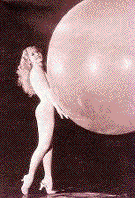
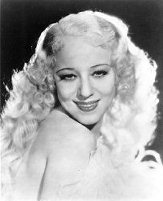
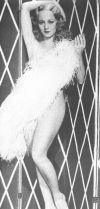
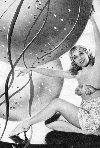
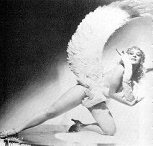
BOOKS
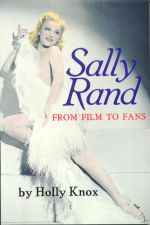
"Sally Rand - From Film to Fans," by Holly Knox (Maverick Publications, 1988). The book is out of print, but you may still be able to get a copy from: Richard Bloomfield, 10693 Chestnut Street, Los Alamitos, CA 90720-2143.